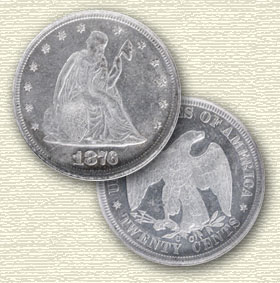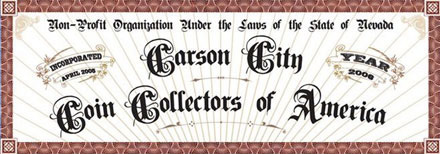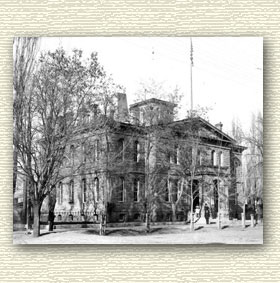- Posts: 499
- Thank you received: 0
1877-CC $10 Carson City Coin of the Week 7-17-2011
A Difficult Time for Americans, Native and Otherwise.
During the Spring and Summer of 1877, the nation was captivated by a human drama that played itself out over a period of several months. Fighting for their very existence against overwhelming military might and impossible odds, a band of 700 Nez Perce fought a running, 1,500 mile battle against the 7th Cavalry of the United States.
Slogging through inhospitable, open territory in Oregon, Idaho, Wyoming and Montana, the Nez Perce continued to win battles while fighting their way north towards freedom in Canada.
Ultimately, they could not win. Their brave, but dispirited leader Hin-mah-too-yah-lat-kekt finally surrendered just 40 miles south of the Canadian border. Better known to the public as Chief Joseph, his formal surrender speech ended with the famous words;
"My heart is sick and sad. From where the sun now stands, I will fight no more forever."
It's too large a transition to smoothly change from such an important and moving part of American history, over to the subject of Carson City coins. So, I won't try. I will only say that it was impossible for this writer to studying the production of the 1877-CC Eagle, all 3,332 of which were minted in August of 1877, while ignoring the unconscionable, yet inevitable events occurring at the same exact time, not far to the north.
1877 - Third Lowest Mintage in CC $10 Series...Why?
Back in Carson City Nevada, the days of August were blistering hot. One can only imagine how difficult were the conditions on the refining floors of the Carson City mint.
While coinage business in 1877 seemed to going extremely well in general, the tiny mintage of only 3,332 1877-CC Eagles produced that August would ultimately represent the entire year's total. This would be the Carson City mint's lowest mintage total of $10 Eagles during its entire eight years of coin production. This also represented the third year in a row where total gold eagle mintage had declined, since the high point in 1874 when 16,767 gold, ten dollar pieces entered circulation with the venerable "CC" impressed on their reverse.
This extremely low gold eagle production does not seem to make much sense, especially given the country's shift to a gold standard just four years earlier. One might turn to the Carson City mint's politically beleaguered history as one potential cause for such miniscule gold eagle production. But, a closer look reveals that gold eagle production had also waned on the national scale since 1874, not just at Carson City.
Despite 1873 Gold Standard - Eagle Production Declines Nationally
From a high of about 80,000 gold eagles production in total by all the nation's mints in 1874, total mintage declined to 7,815 in 1875, just 10,383 in 1876 and 21,129 in 1877.
At first glance, the San Francisco mint's production of 17,000 gold eagles in 1877, seemed respectable as compared to Carson City's paltry total of 3,332. However, the west coast mint's 17,000 gold eagles actually represents the lowest production total* for the San Francisco mint for the next thirty years, through the end of the Liberty Head series in 1907!
* Not including 1890, 1891 and 1904 when no $10 gold coins were produced at the San Francisco mint.
Perhaps, the deep, financial depression in the United States, then in its third, was to blame for the low gold eagle production in 1877. Statistics show that approximately 3,000,000 people were unemployed, an unheard of 27% of the country's entire working population! Many business were only able to produce six months of work per year, most were forced to cut wages by as much as 45% on top of the reduced work hours. The drastically slashed hours and wages precipitated several major strikes in various large industries. Hyper stressed business owners retaliated with further cuts and lockouts. Such actions ultimately solved nothing and only increased the general level of misery across the nation.
One sad time marker emphasizing this period's difficulties was the death of former Carson City mint Superintendant, Henry F. Rice. Rusty Goe recounts in his book James Crawford Master of the Mint at Carson City - A Short Full Life, that after Rice's stock brokerage firm had failed early in 1877, Rice was unable to shake his depression, ultimately taking his own life a few days before Thanksgiving. The loss of such a well known, prominent citizen shocked the entire Comstock region.
Is it any wonder why so few $10 gold pieces were produced in the three year span of 1875 through 1877? Is it conceivable that the many negative social and fiscal pressures on the nation, and in turn, the Comstock region's commerce, may have contributed to the reduced gold eagle production in 1877 at the little Nevada mint?
In Rusty Goe's book, we learn that Superintendent Crawford was directed to release 15 employees mid-way through 1877. Was this due to economic pressures felt by the Treasury Department, or was this simply another political bomb tossed at the Nevada mint in an effort to close the doors in Carson City and swing the business to San Francisco?
Total Carson City Coin Production Belies Scant Eagle Mintage
Running counter to the suppositions that politics and the bad economy were the root causes for Carson City's low gold eagle production is the mint's total coin production for 1877 of 13,900,577 (all denominations included). In the mint's 21 years of production, this total is exceeded only by the 15,839,024 coins minted in 1876, no other year comes close. In 1876 and again in 1877, dimes were minted in the greatest numbers, quarters second and half dollars third. Gold eagles represented, by far, the smallest mintage totals of any denomination in both 1876 and 1877.
Collectability - Then and Now
In The Gold Coins of the Carson City Mint, Douglas Winter states; "...there were no coin collectors in the Carson City area in the 19th century... the few high grade coins that exist from this time have survived by accident or circumstance."
Let's face it, very few citizens of the Comstock region in 1877 had the means to hold on to $10 gold eagles without passing them quickly in daily commerce. If this were not true, there would likely be a greater number of Mint State and Almost Uncirculated, Carson City eagles in existence today.
Try This Experiment
Compare several examples of Carson City gold eagles from the 1870s and the 1880s with gold Eagles minted in Philadelphia or San Francisco. Make sure the comparison coins are all of the same date and the same certified condition.
You will find that, almost without exception, that the Carson City gold eagles will have inferior eye appeal. The CC coins will appear very banged up with heavily abraded surfaces and little, or no, remaining luster. When comparing the CC eagles with their brethren from other mints, you may be surprises that they have the same grade.
The difference in condition has nothing to do with the coins' make-up and everything to do with the coins' environment after leaving the mint. While I am no expert, I suspect that certification companies like PCGS and NGC must take into account the Carson City coins' early release directly into the rough and tumble, wild west when grading. Thus, standards for certification and grading may be slightly different depending on which branch mint produced the coin, rendering an AU certified CC eagle frequently looking worse off than a Philly eagle of the same grade.
Here's the rub...that same beat-up CC eagle will most likely be worth a lot more than the Philly coin, despite the latter's superior eye appeal! As you can imagine, high-grade examples of Carson City eagles with minimal surface abrasion and some remaining luster are very highly prized.
Extant Populations of 1877-CC Eagles
As a group, Carson City eagles dated 1870 through 1879 are extremely rare in uncirculated condition. As previously discussed, gold $10 Eagles produced at the Carson City mint were workhorses that went directly into the region's commerce from day one. None were set aside in uncirculated condition, at least none that have surfaced thus far.
Be that as it may, many contemporary reference books suggest the possible existence of 1 or 2 uncirculated 1877-CC Eagles. None are listed as certified under PCGS's or NGC's data base and your ever-diligent author could not find information about any specific non-certified, uncirculated examples held in private collections to share with his C4OA readers.
The following is a combined PCGS and NGC census total for the 1877-CC Eagle;
Total Remaining In All Grades: 65 - 80
PCGS & VGC Combined Certified Population
(many are duplicate submissions)
VG-VF ~ 27
40-45 ~ 35
50 ~ 10
53 ~ 7
55 ~ 5
58 ~ 2*
*1 PCGS and 1 NGC - Likely the same coin, per D. Winters.
Note: Rusty Goe and other numismatists estimate that 1 or 2 unknown UNCs may exist.
Value and Pricing of 1877-CC Eagle
For anyone interested in collecting Carson City gold coins, the paucity of Mint-State and high-grade, Almost-Uncirculated examples is a hard and fast reality that we must accept. A wise CC Eagle collector once said...
ACCEPTING reality is discouraging. ACQUIESCING, is expensive.
~ NGC Price Guide ~
F ~ 4,140
VF ~ 5,160
XF ~ 8,060
50 ~ 14,380
53 ~ 20,630
55 ~ 31,880
58 -
~ PCGS Price Guide ~
F ~ 5,000
VF ~ 5,500 - 6,500
XF ~ 11,500 - 13,500
50 ~ 18,500
53 ~ 25,000
55 ~ 35,000
58 ~ 50,000
CC coins would have more surface dings and abbrasions, even at this high grade.
Recent Sale Examples
AU-53 PCGS $21,850 March, 2011 - Heritage Auction Sacramento
XF-45 PCGS $9,775 January, 2011 - Heritage Auction Tampa
F-12 PCGS $4,313 January, 2011 - Heritage Auction Tampa
Given the difficulty of finding a quality example of the 1877-CC Eagle in most grades, this writer believes that conditionally superior examples of the 1877-CC Eagle may not be fully appreciated by the market when compared to other well known Carson City rarities. I've learned from first-hand experience that it's one thing to gauge the rarity and collectability of a coin by academic study and careful review of references. It's quite another to be in the market year after year for the coin and being forced to reject example after example due to problems, extremely poor eye appeal, massive over-pricing, or worst of all...getting out-bid when a quality example finally comes up.
Simply stated, a truly worthy example of the 1877-CC Eagle is a very tough coin to identify and successfully acquire in any grade! Astute collectors know this and are loath to put their high grade examples on the market for any reason. Even the Smithsonian Institution has faced this reality. The museum's best example of the 1877-CC Eagle is an XF-45!
A Writer's Conclusion
I always enjoy researching Carson City coins in preparation for writing a Coin of the Week article. Rarely do I encounter a coin/date that is not full of riddles, or whose published facts are full of holes. But, of course, this is one of the reasons the entire Carson City series from dimes through double eagles is so fascinating. One always feels as if there is so much left to discover.
Researching the July 17, 2011 Carson City Coin of the Week, the 1877-CC Eagle was no different. I followed facts which combined with questions to produce mysteries. In turn, mysteries combined with time and became legend.
Such is the enigmatic nature, and the frequently impenetrable history, of the unique coins produced at the US Branch mint in Carson City, Nevada between 1870 and 1893.
Belay Off
C4OA Lifer!
Please Log in to join the conversation.
You have used your investigative skills to ferret out many interesting facts, questions, and speculations regarding 1877-CC gold eagles and the year in which they were made.
One explanation why the mints produced so few $10 gold pieces (and $5 pieces) during the mid-1870s is these lower denomination coins were the coins used in everyday commercial transactions, and as you pointed out, the nation suffered through a severe recession (depression) during those years. There simply was not as much demand for the lower denomination gold coins. Double eagles, on the other hand, were used in bank-to-bank settlements and international trade. You can easily see that there was a huge demand for these large double eagle gold coins by the comparatively high mintages of them at this time.
Another thing to keep in mind when discussing mintage figures for "CC" coins in general during 1876 and 1877 is that these were peak years of production on the Comstock Lode. This would account for the peak years of coin production in these two years at the Carson City Mint. This correlates with your statement:
Then, of course, we know that an order went out to all mints at this time to produce massive quantities of subsidiary silver coins in preparation for specie resumption set to begin in due time (Gold eagles, of course, played no part in this plan).the mint's total coin production for 1877 of 13,900,577 (all denominations included). In the mint's 21 years of production, this total is exceeded only by the 15,839,024 coins minted in 1876, no other year comes close.
You wrote,
This is as true a statement as could ever be made.conditionally superior examples of the 1877-CC Eagle may not be fully appreciated by the market when compared to other well known Carson City rarities.
You hit the nail square on the head when you wrote,
I have been researching this subject for many years, and still feel the more I learn the more I need to learn.But, of course, this is one of the reasons the entire Carson City series from dimes through double eagles is so fascinating. One always feels as if there is so much left to discover.
Good thought-provoking article Belay.
Rusty
C4OA Lifer!
Please Log in to join the conversation.
- coindrummer
-

- Offline
- Platinum Member
-

- Michael D. Parrott
- Posts: 775
- Thank you received: 0
Another fantastic COW post. You have proven without a doubt to be our top COW poster. Many collectors today (other than C4OAers) don't fully realize the rarity of this issue, especially in the higher grades.
I love your coin you have pictured....what a honey!
the drummer
C4OA Lifer!
Please Log in to join the conversation.
- Loosechange
- Offline
- Platinum Member
-

- Married to my best friend!
- Posts: 504
- Thank you received: 0
Loosechange
Go "CC'S"
Please Log in to join the conversation.
It makes tremendous sense that the $5 and $10 gold denominations were impractical, especially during the height of a national economic depression. It's easy for 21st century citizens to fail to recognize just how much money $5 or $10 was back then.
Unfortunately, I was really pressed for time this weekend and was not able to adequately proof the article which I wrote between lunch and dinner on Sunday. It's not the best writing I've ever done, to say the least...but it's was still enjoyable and worthwhile to do the research and learn a little more about the '77-CC Eagle.
Belay Off
C4OA Lifer!
Please Log in to join the conversation.


